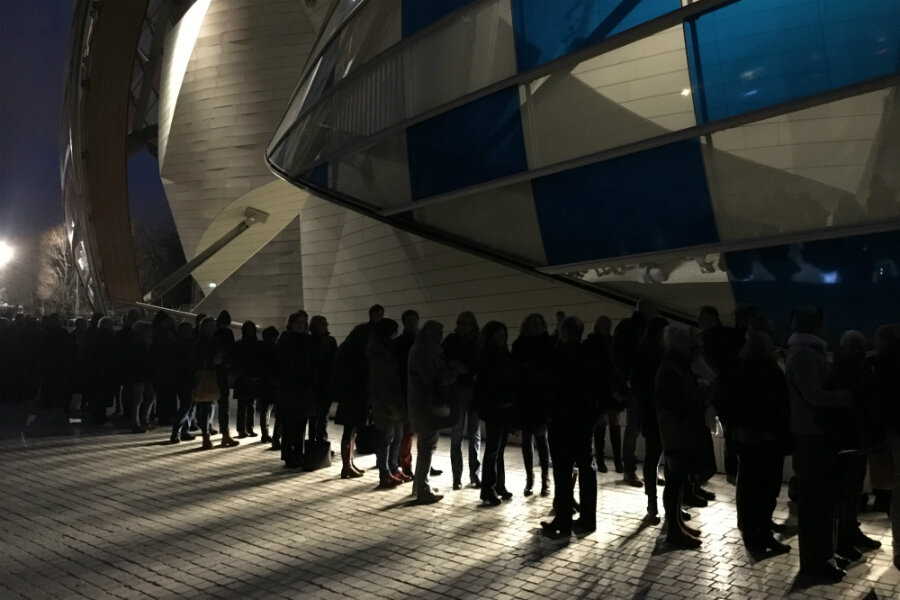Up before dawn to see Shchukin, the hottest art exhibit in Paris
Loading...
| Paris
It’s 6:15 a.m., and Paris is still dark. Traversing the Bois de Boulogne, a park on the western edge of the city, there is not a soul.
Yet at the Foundation Luis Vuitton in the center of the parkland, it could be the middle of the day, save for the fact that the sun still hasn’t risen. By 6:45 a.m., people in line for the blowout exhibit “Icons of Modern Art: The Shchukin Collection” are tense. “If these people all reserved for 7 a.m., we are never going to get in,” says one man nervously to his friends standing in the “no reservation” queue.
The collection on display here of Russian industrialist Sergei Shchukin, considered one of the finest in the world, has turned into the most popular exhibit in 50 years in Paris. More than a million people have streamed through the doors of the private gallery, and to deal with the demand, the foundation opened at 7 a.m. in its final week.
The popularity of “Icons of Modern Art" clearly owes to the collection itself. Mr. Shchukin amassed more than 250 masterpieces by Matisse, Gaugin, Picasso, and Monet, 130 of them on display here. This is the first time the collection has been reunited since it was broken up by Stalin and the first time it has left Russia together – a testament to art’s capacity to transcend revolution, war, banishment, and the politics of the day.
“When a friend told me she was going to see the ‘Shchukin’ exhibit, I asked myself, who is this person?” I did some research about this collection, I said, ‘Oh la la la la.’ I thought to myself, ‘I must see this,’” says Josée Climent, who is retired and traveled from Montpellier to see the show.
“Everyone is talking about Shchukin, Shchukin,” says Nicolas Mengaud, who set an alarm at 5:20 a.m. and took a vacation day to be here, standing first in the line for his 7:30 a.m. slot. “I’d never heard of him.”
Mr. Shchukin was a Russian industrialist who, on his business trips to Paris at the end of the 19th century, began bringing home the Impressionist, post-Impressionist, and modern masters of the day, filling the walls of his home in Moscow. Derided at home, he took little notice. "If a painting gives you a psychological shock, you should buy it,” he once said.
His buying spree was short-lived. A year after the Bolshevik Revolution in 1917, he went into exile a year, and the collection was nationalized. It was evacuated to Siberia after the Germans attacked the Soviet Union in 1941. After the war, Stalin ordered the its dissolution, declaring the works “bourgeois art.”
While much of the intrigue around the Shchukin collection focuses on its nationalization after the Bolshevik Revolution, which marks its centenary this year, his collection also highlights an era that led up to the much-overshadowed February Revolution of the same year. Correspondent Fred Weir writes about that short-lived period in 1917, when a mix of pro-Western liberals and democrats held power, in next week’s print edition of The Christian Science Monitor.
Preceding the February Revolution was a period of frenzied art-purchasing by Shchukin, who bought his entire collection in less than two decades, and other members of the merchant class who were called the “Russian Rockefellers and Carnegies and Fricks” in a 1983 New York Times book review of “The Merchant Patrons of Modern Art In Pre-Revolutionary Russia” by Beverly Whitney Kean.
"There was a strange, artificial, hothouse atmosphere in Russia at the turn of the century, a sense of forced growth and impending metamorphosis," biographer Whitney Kean wrote of the industrialist collectors.
Shchukin’s collection was broken up by the state in 1948 and split between the Hermitage and Pushkin museums in Russia. Its reunion – a diplomatic feat, and victory over its troubled history – amounts to nothing short of a “miracle,” Anne Baldassari, curator of the exhibit, told CNBC in an on-air interview.
It opened last fall during a chapter of tension between the West and Russia – over the annexation of Ukraine, Russia’s military involvement in Syria, and accusations of hacking and meddling in Western elections from the US to France. Russian President Vladimir Putin never made it to the exhibit. He canceled a trip to France that would have coincided with the opening, in response to French President François Hollande’s comments that Russian intervention in Aleppo was a “war crime.”
But few others have stayed away. According to the cultural pages of Le Monde, it’s the most visited exhibit since “Toutankhamon” at the Petite Palais in 1967, which drew 1.2 million visitors in just over five months.
The Foundation Louis Vuitton took steps to respond, extending the show by two weeks and keeping its doors open until 11 p.m. On Saturday, the night before it closes, doors will be open until 1 a.m.
But it is the early risers on Friday who say they have experienced something enthralling. Minutes after opening, the 14 galleries are still nearly empty. Visitors who have finally gotten through the queues and into the exhibit can take in Matisse's "Red Room" or Cezanne’s "Mardi Gras" practically alone.
Ms. Climent, the retiree, calls Matisse her “heart-stopper.” But in the Gauguin room, she was able to stand by herself for several minutes in front of the artist's “Aha Oe Feii?” ("Are you jealous?")
As she recounts her visit, it’s nearing 8:30 a.m. The rooms are starting to fill. By 9 a.m., visitors have to queue up to see practically every work of art on display.
But Climent has already experienced the entire exhibition. “To walk through here, and breath, in this magical place,” she says. “It has been exceptional.”






